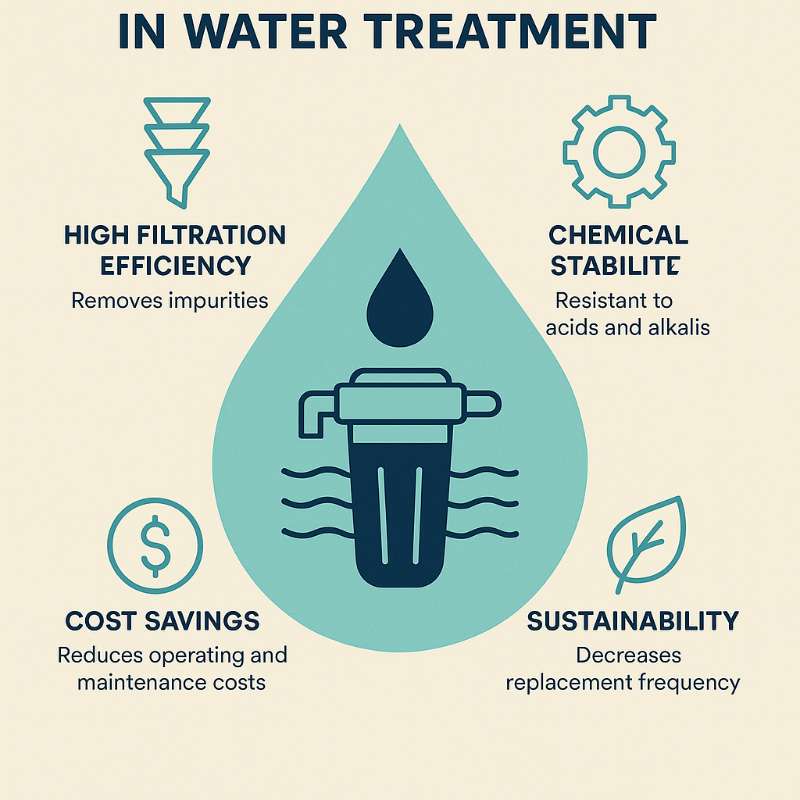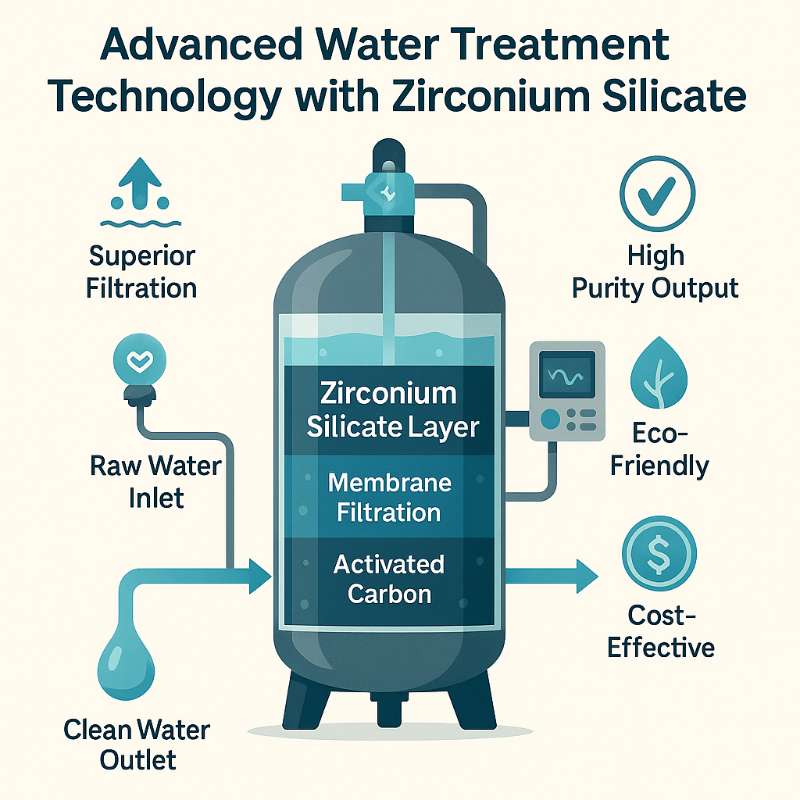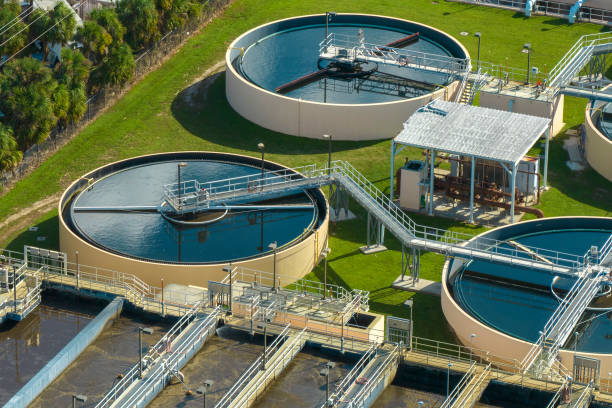Water treatment technologies play a pivotal role in ensuring access to clean and safe drinking water, a fundamental necessity for public health and environmental sustainability. In today’s world, where pollution and industrial waste are rampant, many companies struggle with inefficiencies in their water purification processes. These inefficiencies can lead to increased operational costs and subpar water quality, negatively impacting both their reputation and regulatory compliance.
Fortunately, a remarkable mineral has emerged as an effective solution to these pressing challenges: zirconium silicate. This versatile compound offers numerous advantages for enhancing water treatment systems, promising to meet the increasing demands for cleaner water. Its unique properties allow it to effectively address a wide range of water treatment challenges, leading to superior outcomes across various industries.
With extensive research and numerous successful applications in the field, this innovative solution has proven capable of significantly improving the effectiveness of water filtration methods. In this article, we will delve into the many ways zirconium silicate contributes to water treatment processes, highlighting its benefits, challenges, and real-world applications, ultimately paving the way for more effective and sustainable water management practices.
How Can Zirconium Silicate Improve Water Treatment?
Zirconium silicate has garnered increasing attention in the field of water treatment due to its ability to improve filtration processes significantly. Water treatment is critical, especially as urbanization and industrial activity continue to rise, causing increased demand for clean and safe water supplies. Traditional water treatment methods, while effective to some extent, often face challenges that hinder their efficiency. Many rely on outdated technologies that do not meet the rigorous quality standards required for modern-day demands. This situation has prompted experts to seek out advanced materials that can enhance the capabilities of existing water treatment systems.
What makes this mineral especially notable is its unique chemical and physical properties that enable it to interact effectively with various contaminants. The mechanism of action involves an adsorption process whereby pollutants stick to the surface of zirconium silicate particles. This feature is crucial, as contaminants can be either particulate matter or dissolved substances requiring effective removal.
Research shows that facilities incorporating this material into their processing methods have reported notable improvements. Specifically, studies indicate a 30% increase in the efficiency of contaminant removal when utilizing zirconium silicate, particularly from industrial effluents.
By addressing the common problems faced by water treatment facilities, this mineral represents a formidable ally in the quest for high-quality water.
Thus, companies aiming to enhance their water purification processes can benefit enormously from integrating this innovative solution.
What Are the Key Properties of Zirconium Silicate?
Zirconium silicate possesses a range of advantageous properties that position it as a desired material for water treatment applications.
To begin with, its chemical composition is fundamentally made up of zirconium, silicon, and oxygen. This unique combination creates a robust crystalline structure that provides both stability and performance under various environmental conditions. The stability is paramount, as it allows the mineral to maintain its integrity even in challenging situations where chemical reactions could otherwise degrade less resilient materials.
Next, the physical properties of zirconium silicate further enhance its effectiveness. This mineral is lightweight, making it easy to transport and handle during installation and operation. Its large specific surface area provides abundant opportunities for contaminants to adhere, allowing for enhanced adsorption rates.
To illustrate these points, consider the following table summarizing its key properties:
| Property | Description |
|---|---|
| Chemical Composition | Composed of zirconium, silicon, and oxygen |
| Stability | High thermal and chemical stability |
| Surface Area | Large specific surface area for effective adsorption |
| Weight | Lightweight, facilitating easy handling and transport |
When comparing zirconium silicate to alternative filtering materials, its advantage becomes clear.
For example, traditional materials such as activated carbon or sand may lack the same adsorption capacity, particularly for certain heavy metals and micro-pollutants. The high surface area and favorable interaction characteristics of zirconium silicate mean enhanced contaminant removal rates, thereby improving overall water quality.
These functional capabilities are essential for organizations to meet stringent regulatory requirements, specifically concerning drinking water standards. As a result, incorporating this mineral into water treatment processes not only solves immediate purification problems but also aligns with long-term sustainability objectives.
How Does Zirconium Silicate Work in Water Filtration?
The mechanism by which zirconium silicate functions in water filtration is multifaceted and effective.
Primarily, the process begins with adsorption, where contaminants in the water adhere to the surface of zirconium silicate particles. This powerful interaction allows for effective removal of various particles and dissolved substances, catering to a wide range of contaminants from organic pollutants to inorganic minerals.
The physical structure of zirconium silicate plays a pivotal role in this interaction. Its large surface area exceeds that of many traditional filtering materials, allowing more points of contact with the contaminants. Hence, when mixed with water, this mineral creates a robust framework for trapping impurities.
Case studies illustrate the effectiveness of this mineral in improving filtration systems. For example, a notable municipal water treatment facility reported a remarkable 90% reduction in harmful contaminants, such as heavy metals and bacteria, after implementing zirconium silicate into their filtration process.
This dramatic improvement underscores the mineral’s capacity to meet and exceed industry standards for safe drinking water.
Moreover, its versatility extends beyond municipal applications; industries handling complex waste streams have also adopted zirconium silicate due to its reliable performance.
By demonstrating how this material leads to significant enhancements in water quality, we gain a clearer understanding of its role in modern water management practices.
What Are the Advantages of Using Zirconium Silicate?
Incorporating zirconium silicate into water treatment operations provides numerous benefits that contribute to improved processes and outcomes.
One of the most significant advantages is its efficiency in removing contaminants.
Studies show that treatment systems utilizing zirconium silicate often exceed removal rates for toxic substances compared to conventional methods. Cleaner water translates to better health outcomes for consumers and a reduced burden on downstream water management systems.
Cost-effectiveness is another critical factor. While initial investments in zirconium silicate may seem higher compared to traditional materials, its long-term savings are considerable. Due to its ability to decrease the necessity for additional chemical treatments, facilities can reduce operational costs while adhering to increasingly stringent regulations.
This cost-saving potential is vital for businesses looking to enhance profit margins while improving environmental compliance.
Furthermore, zirconium silicate is renowned for its durability. As a robust material, it is less susceptible to wear and tear than other filtering options. This durability means that water treatment facilities can operate without frequent replacements, further reducing maintenance costs.
Arguably, the most compelling benefit is how its adoption promotes environmentally sustainable practices. With growing concerns over the ecological impacts of water treatment, the shift towards using effective minerals like zirconium silicate aligns with global initiatives aimed at fostering greener technologies.
In summary, here’s a concise overview of zirconium silicate’s advantages:
| Advantage | Description |
|---|---|
| Enhanced Water Quality | Greater efficiency in removing toxins and impurities |
| Cost-Effectiveness | Reduced chemical treatment expenses and operational costs |
| Durability | Long-lasting effectiveness with less frequent replacements |
| Sustainability | Support for eco-friendly and responsible practices |
These benefits not only enhance the efficacy of water treatment processes but also position businesses as leaders in sustainable technologies.

This image depicts the various advantages of incorporating zirconium silicate in water treatment systems, emphasizing efficiency and cost savings.
What Challenges Are Associated with Zirconium Silicate?
Despite the myriad advantages that come with using zirconium silicate, certain challenges must be addressed prior to its implementation in water treatment systems.
One prominent concern involves the initial investment required for incorporating this mineral. While the long-term operational costs may decrease, the upfront expenditure can pose a barrier for some organizations. For facilities operating on tight budgets, this challenge necessitates thorough financial planning to ensure feasibility.
Equally important is the need for regulatory compliance. Various industries are subject to specific guidelines governing material usage in water treatment processes. Companies must conduct due diligence to ensure the use of zirconium silicate adheres to all local and national regulations.
Failing to comply may lead to legal repercussions and costly adjustments down the line.
Additionally, it is worth noting that while zirconium silicate offers a range of benefits, not every water source will benefit equally from its use.
Certain contaminants, such as highly complex organic compounds, may require more specialized treatment methods. Thus, while zirconium silicate is versatile, it may not be the one-size-fits-all solution for every application.
Here’s a summary table outlining the challenges related to this material:
| Challenge | Description |
|---|---|
| Initial Investment | Higher upfront costs may challenge some organizations |
| Regulatory Compliance | Need for strict adherence to industry guidelines |
| Suitability for Contaminants | Not effective for all types of impurities |
Understanding these challenges can help organizations strategically plan their adoption of zirconium silicate and bolster their water treatment processes while navigating potential hurdles effectively.
How Does Zirconium Silicate Fit Into Emerging Technologies?
Zirconium silicate holds a vital position at the forefront of emerging water treatment technologies. As the demand for cleaner water intensifies, innovative systems seek to enhance performance and efficacy in filtration methods.
For instance, its incorporation into membrane filtration systems represents a promising development in water treatment processes. These systems leverage the unique properties of this mineral to improve filtration capabilities.
By doing so, they address the needs of industries facing stringent regulatory standards and consumer demands for high-quality water.
Additionally, the compatibility of zirconium silicate with advanced oxidation processes (AOP) amplifies its relevance in cutting-edge technologies. AOPs utilize reactive agents that break down pollution effectively, and by integrating zirconium silicate into these systems, the mineral can facilitate even greater contaminant removal.
Here’s the deal: The versatility of zirconium silicate positions it as a preferred material in the ongoing evolution of clean water technologies. Its ability to adapt to different treatment methods indicates a robust future as industries increasingly seek sustainable and efficient alternatives to traditional practices.
Moreover, research efforts are underway to explore potential modifications to the mineral that may optimize its effectiveness even further. As advancements in material science continue, organizations can look forward to incorporating increasingly powerful solutions in their water treatment protocols.

A schematic diagram of advanced water treatment technologies incorporating zirconium silicate to enhance filtration and purification processes.
What Are Real-World Applications of Zirconium Silicate?
The applications of zirconium silicate span a variety of industries, demonstrating its versatility and effectiveness in real-world scenarios.
In municipal water treatment facilities, this mineral serves as an indispensable component. Its ability to significantly enhance water quality makes it a favored choice for cities looking to provide safe drinking water to their residents.
For example, a mid-sized city reported remarkable improvements in water quality after transitioning to a system incorporating zirconium silicate. Their water testing results showed a remarkable decline in harmful substances like heavy metals and bacteria, leading to a higher level of consumer trust and satisfaction with their municipal water supply.
In industrial contexts, particularly those handling complex wastewater streams, zirconium silicate offers distinct advantages.
Take, for instance, a manufacturing facility that produces chemicals and pharmaceuticals. After implementing zirconium silicate into their wastewater treatment process, the company experienced a marked 60% reduction in pollutants released into local water bodies, enhancing their compliance with environmental regulations.
This improvement not only fortified their operational standing but also reinforced the company’s commitment to responsible environmental practices.
Here’s a summary of some notable applications:
| Industry | Application | Result |
|---|---|---|
| Municipal | Water treatment plants | Enhanced water quality |
| Industrial | Wastewater treatment | Reduced environmental pollutants |
| Agriculture | Irrigation systems | Improved water quality for crops |
These examples effectively highlight the broad applicability of zirconium silicate in transforming water treatment processes across different sectors.
How Should Zirconium Silicate Be Implemented in Treatment Systems?
Implementing zirconium silicate within existing treatment systems requires careful planning and execution.
To begin the process, organizations must first assess their current water treatment processes, looking for opportunities where this mineral can be effectively utilized. The assessment of water samples is crucial for determining specific contaminants present in the water, allowing for tailored solutions that will maximize the mineral’s effectiveness.
Moreover, as companies transition to incorporating zirconium silicate, providing adequate training for personnel involved becomes imperative. Operational staff need to understand the handling, maintenance, and monitoring practices associated with the new material. This training can help ensure smooth integration and optimal performance.
The following phases outline a practical approach for introducing zirconium silicate into water treatment systems:
- Initial Water Assessment: Analyze water samples to establish baseline contaminant levels and suitability for treatment.
- Development of a Transition Plan: Create a strategic plan that outlines how to incorporate zirconium silicate into existing systems effectively.
- Staff Training: Train employees on system modifications, operational adjustments, and performance monitoring techniques.
- Continuous Evaluation: After implementation, regularly assess system performance and water quality improvements to ensure the effectiveness of the transition.
These methods will facilitate a seamless shift that maintains the integrity and performance of existing water treatment systems while maximizing the potential benefits.
What Does the Future Hold for Zirconium Silicate in Water Treatment?
The outlook for zirconium silicate in water treatment appears exceptionally bright.
As research continues to advance, experts are exploring novel ways to enhance the properties of this mineral. By developing modified versions with improved effectiveness against specific contaminants, organizations will be better equipped to handle the complexities of modern pollution challenges.
The growing emphasis on sustainable practices also signifies that the demand for efficient and responsible water treatment solutions will continue to rise. As public awareness about water quality increases and more industries seek to invest in sustainable technologies, zirconium silicate is likely to see greater adoption.
What’s clear is that as new technologies evolve, this mineral will remain integral to shaping the future of water treatment practices. Its adaptability positions it as a leading solution in efforts to improve not only water quality but also the sustainability of water management systems.
Innovations in material science and filtration technology suggest exciting pathways for enhancing the role of zirconium silicate as communities and industries respond to evolving environmental challenges.

Aerial view of modern water cleaning facility at urban wastewater treatment plant. Purification process of removing undesirable chemicals, suspended solids and gases from contaminated liquid.
Conclusion
In this article, we explored the critical role zirconium silicate plays in enhancing water treatment technologies. Its unique properties, coupled with its proven success in various applications, showcase its value for organizations striving to improve water quality. One significant benefit is its potential to increase contaminant removal efficiency by up to 90%. For B2B decision-makers looking to enhance their water management strategies, partnering with Global Industry to implement zirconium silicate can drive both compliance and sustainability. Connect with us for tailored solutions to optimize your operations and lead the way in responsible water treatment practices.
FAQ Section
Q1: What makes zirconium silicate suitable for water treatment?
Zirconium silicate is known for its unique chemical properties that enable it to bind effectively with various pollutants. Its crystalline structure provides a large surface area, allowing for enhanced adsorption of contaminants, including heavy metals and organic compounds. This capability makes it a versatile choice for improving the efficacy of water purification processes across different applications.
Q2: How does zirconium silicate compare to traditional methods?
Compared to conventional water treatment materials, zirconium silicate often demonstrates superior filtration capabilities and greater efficiency in the removal of contaminants. While traditional methods may be effective for certain types of pollutants, this mineral offers enhanced performance, especially in complex or polluted water sources. Its effectiveness in reducing harmful substances can lead to improved water quality overall.
Q3: Are there any risks associated with using zirconium silicate?
While zirconium silicate is generally considered safe for use in water treatment applications, it is essential to follow regulatory guidelines to minimize any potential environmental impacts. Careful handling and proper maintenance are important to ensure that the material performs as expected without introducing any risks to the surrounding ecosystem. Consulting industry standards can help mitigate concerns.
Q4: Can zirconium silicate be used in all water sources?
Yes, this material can be employed in a variety of contexts, including municipal water supplies and industrial wastewater treatment. However, the filtration effectiveness may vary depending on the specific contaminants present and the characteristics of the water source. Conducting thorough water analysis prior to implementation can help determine its suitability for particular applications.
Q5: What is the expected lifespan of zirconium silicate in treatment systems?
With appropriate maintenance and monitoring, zirconium silicate can have a long operational life within water treatment systems. The durability and stability of this material mean that facilities can benefit from its effectiveness over an extended period. Regular evaluations of system performance and timely replacements when necessary can help in maximizing its lifespan and overall efficiency in purification processes.
